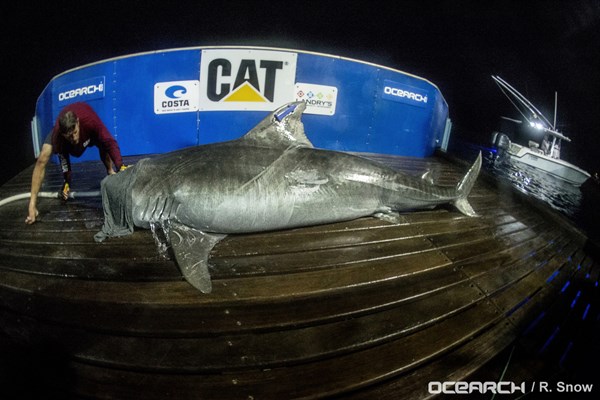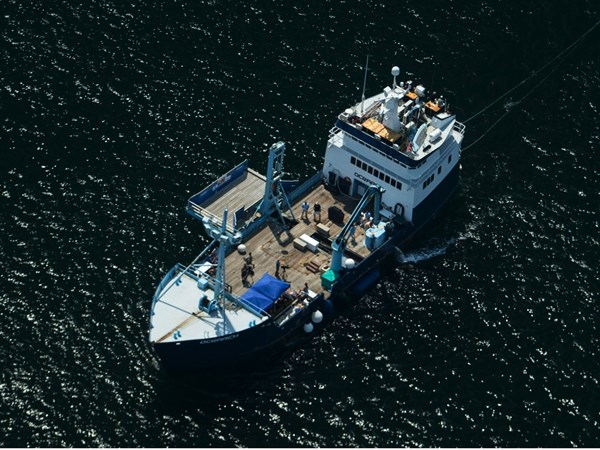PARK CITY, Utah, Jan. 16, 2015 (GLOBE NEWSWIRE) --
The primary aim of studying the sharks' migratory patterns is achieving safer beaches, while ensuring the sustainability of an often-feared creature.
In a world first OCEARCH is bringing its unique research vessel MV OCEARCH (the only one of its kind) to Queensland, Northern Territory and Western Australia to study tiger sharks with some of Australia's best shark scientists.
The knowledge boost on tiger shark movements will provide Australian scientists with the most accurate data (to date), while everyone will be able to tap into near-real time, free satellite shark tracking for themselves.
Its maiden Australian voyage is being launched in Brisbane on January 30 with scientists from as far away as Tokyo, Argentina and the US joining researchers from the University of Queensland, James Cook University, the University of Western Australia and the University of Tasmania.
James Cook University's Dr. Adam Barnett described the OCEARCH expedition as a great opportunity to advance Australia's research program.
"We have the chance to tag more tiger sharks with OCEARCH satellite technology over a period of a few weeks than our team has in the past 14 years in Queensland waters," Dr. Barnett said. "OCEARCH and Caterpillar are providing a true gift to Queensland and to our team."
"Having hands-on, safe access to live mature tiger sharks will be a significant boost to research, allowing us to conduct projects that are undoable in the water, providing data we could never have dreamed of achieving on our own. Researchers in this area are crying out for funding so to have access to the resources of this calibre is the best start to the New Year."
The expedition is largely funded by Caterpillar Inc. (Australia's largest mining support company) as part of an on-going commitment to ocean sustainability and social innovation.
"We recognize the significance of the work OCEARCH is undertaking to improve waters around the globe," said Lantz-Rickard, Caterpillar's Global Brand Marketing Manager Diane Lantz-Rickard.
"As a Caterpillar customer, OCEARCH believes in the reliability of our products and the support it receives from our global dealers while on expeditions – including this latest one off the coast of Australia. It's thrilling to know that our engines, people and brand are playing a small part in advancing our knowledge of vast oceans around the world."
OCEARCH has collaborated with over 70 scientists and 40 international institutions since 2007, and made significant contributions to global shark research, with dozens of research papers in progress or published.
The team combines the skill of fishermen and knowledge of scientists to board large sharks onto an over-water platform for sampling and tagging. The satellite tags, properly known as SPOT (Smart Position and Temperature) tags, provide near-real time locations of sharks available for free online at ocearch.org or by using the Global Shark Tracker App available on Apple and Droid platforms.
Founding Chairman and Expedition Leader, Chris Fischer, said OCEARCH data had influenced policy makers in a number of countries resulting in better outcomes for both shark and humans.
"The new data will help provide Australia with a better understanding of when, how and why tiger sharks forage particularly near public beaches," Fischer said. "This project is about delivering previously unattainable data to public safety officials and conservation managers."
"It will be a privilege to serve the Australian people and their tiger shark research community. It's our goal to create the most inclusive, open sourced shark project with the Australian people in history."
Fischer said sharing timely knowledge with the public was key to replacing fear with fascination.
"It's hard to imagine our work began 20 expeditions ago at Guadalupe Island, Mexico where we SPOT tagged and tracked the first mature Great White Sharks in history," he said. "In the process we discovered their full migratory range, mating sites, birthing sites, and areas where they were being caught and killed."
"Pioneering this data allowed for conservation managers to have the science they needed to publish papers and affect policy. Public officials had the confidence of knowing the latest technology, methods, and science was being conducted for the communities they served."
University of Queensland shark scientist Bonnie Holmes will use the expedition to follow up on her recent tiger shark tagging work in South Eastern Australia.
"We are only beginning to understand how these sharks move between the warm temperate waters of New South Wales in the summer, to the sub-tropical and tropical waters of Queensland in winter," Holmes said. "Some of our previously tracked tiger sharks also moved as far east as New Caledonia, so we know their home range is rather significant. With SPOT tags on these animals we will know where they move anywhere in the world, in near-real time, as they come up to fin."
Holmes has also identified Mackay as a critical area where 'north meets south' with respect to the species' movements: so this expedition will include shark tagging in Mackay to identify how tiger sharks are utilizing the Australian east coast in their migration strategies.
Regular updates will be posted on the @Ocearch Twitter handle as well as the OCEARCH Facebook page.
The open-sourcing of data and collaborative approach to science are core to OCEARCH's principle of inclusion. This Australian visit will include school and community events during the group's "down-time" - as well as short films shared from the ship. Any community organization can simply email info@OCEARCH.org to request a visit.
Students will be able to leverage the near real-time shark tracking data to learn math, physics, and other STEM (Science, Technology, Engineering, Math) skills making science relevant in their lives through OCEARCH's free STEM curriculum for 3-8th grade.
Quick Facts:
How the tagging happens:
Using the CAT powered hydraulic elevator and research platform scientists have approximately mature tiger sharks (and other species) to conduct 12 different studies including tagging and sampling. Once caught, the tiger sharks will be measured, sexed, tissue will be collected (blood, muscle and fin clip) and the sharks will be tagged with satellite and acoustic transmitters. Several individuals will also be fitted with accelerometer/camera packages before being released. Data from the accelerometers show that the animals recover and start swimming strongly within 2-4 hours after release.
About OCEARCH
OCEARCH is a non-profit organization with a global reach for unprecedented ocean-based research on apex predators such as Tiger Sharks, supporting leading researchers and institutions seeking to attain groundbreaking data on the movement, biology and health of sharks to protect their future while enhancing public safety. The researchers OCEARCH supports work aboard the MV OCEARCH, a 126' Cat-powered vessel equipped with a 75,000 lb. hydraulic research platform, where the ship serves as both mothership and at-sea laboratory. OCEARCH expeditions are sponsored in large part by Caterpillar Inc. as part of a socially innovative multi-year partnership. Additional partnership support is provided by Costa Sunglasses and Shell, along with DYT Yacht Transport, Contender, Yamaha, SAFE Boats, MUSTAD and Landry's Inc.
About Caterpillar:
For nearly 90 years, Caterpillar Inc. has been making sustainable progress possible and driving positive change on every continent. Customers turn to Caterpillar to help them develop infrastructure, energy and natural resource assets. With 2013 sales and revenues of $55.656 billion, Caterpillar is the world's leading manufacturer of construction and mining equipment, diesel and natural gas engines, industrial gas turbines and diesel-electric locomotives. The company principally operates through its three product segments - Resource Industries, Construction Industries and Energy & Transportation - and also provides financing and related services through its Financial Products segment. Website: http://www.cat.com/builtforit-au
Photos accompanying this release are available at:

